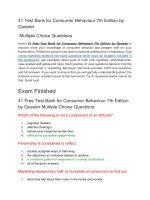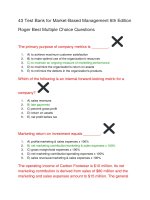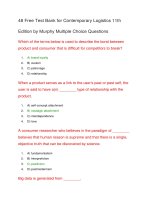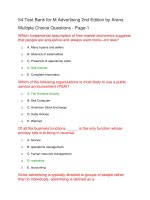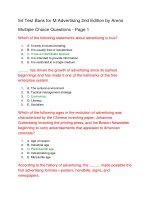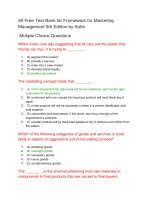61 test bank for global marketing foreign entry, local marketing, and global management 5th edition
Bạn đang xem bản rút gọn của tài liệu. Xem và tải ngay bản đầy đủ của tài liệu tại đây (81.64 KB, 14 trang )
61 Test Bank for Global Marketing Foreign Entry, Local
Marketing, and Global Management 5th Edition
Johansson Multiple Choice Questions - Page 1
(p. 39) Given the intense global competition in many markets, there
is an evidence of:
1.
2.
3.
4.
A. worsening perceptions of American quality.
B. greatly improved perceptions of Japanese quality.
C. worsening perceptions of German quality.
D. a convergence of quality perceptions.
(p. 35) The United State's traditional concern with infrastructure
gives it a favorable position in which of the following portions of
Porter's diamond of national advantage?
1.
2.
3.
4.
A. Factor conditions
B. Demand conditions
C. Related and supporting industries
D. Firm strategy, structure, and rivalry.
(p. 35-36) Which of the following provides a hope for a nation
seeking to develop new skills and gain/renew competitive
advantages?
1.
2.
3.
4.
A. The cycle of competitive advantage
B. The diamond of national advantage
C. The cycle of absolute advantage
D. The circular flow of innovation
(p. 35) One of the best examples of exceptions to the traditional
international product cycle concept can be found in America's
continuing dominance in the area of:
1.
2.
3.
4.
A. automobile production.
B. home entertainment.
C. computer design.
D. textiles.
(p. 34) The fundamental rationale for the existence of international
trade is based upon the principle of:
1.
2.
3.
4.
A. comparative advantage.
B. absolute advantage.
C. political advantage.
D. economic necessity.
(p. 35) The shift of focus of American industry from home
entertainment products such as television and VCRs to computer
design is explained by:
1.
2.
3.
4.
A. the diamond of national advantage model.
B. the circular flow of innovation model.
C. the cycle of absolute advantage model.
D. the international product cycle model.
(p. 34-35) For which of the following advantages is location fixed?
1.
2.
3.
4.
A. Low cost labor
B. Services
C. Knowledge workers
D. Raw materials
(p. 41) A resource-based strategy defines the firm in terms of:
1.
2.
3.
4.
A. the products it markets.
B. the services it markets.
C. the needs it seeks to satisfy.
D. what it is capable of doing.
(p. 35) According to the _____, an innovating country will eventually
import the products it created.
1.
2.
3.
4.
A. international product cycle
B. principle of absolute advantage
C. principle of comparative advantage
D. circular flow of innovation model
(p. 33) The America-First Corporation is preparing to "go global" by
simultaneously entering several foreign markets. To be successful,
the firm must understand:
1.
2.
3.
4.
A. its competitive advantages in these markets.
B. global compensation.
C. import/export laws.
D. electronic communication.
(p. 40) A firm-specific advantage is synonymous with:
1.
2.
3.
4.
A. country-specific advantage.
B. comparative advantage.
C. location-specific advantage.
D. differential advantage.
(p. 35) The theory of comparative advantage is extended by
Porter's concept of:
1.
A. the international product cycle.
2.
3.
4.
B. the circular flow of innovation.
C. the diamond of national advantage.
D. economic Darwinism.
(p. 33) The fundamental aim of business strategy is to create and
maintain:
1.
2.
3.
4.
A. lower prices.
B. efficient channels.
C. a competitive advantage.
D. production efficiency.
(p. 35) A country's absolute advantage may eventually be erased by
foreign competitors through the operation of:
1.
2.
3.
4.
A. political pressure.
B. the international product cycle.
C. cartels.
D. free trade zones.
(p. 34) According to the 1981 Dunning study of comparative
advantage, what advantage did the U.S. have?
1.
2.
3.
4.
A. Technology of all kinds
B. Transportation equipment
C. Food products
D. Mechanical engineering
(p. 38) The "country-of-origin" phenomenon seems to have a
particularly strong impact upon perceptions of:
1.
2.
3.
4.
A. quality.
B. style.
C. price.
D. content.
(p. 34) A country which is more efficient/productive than all other
nations with regard to a specific product or resource is said to have
a(n):
1.
2.
3.
4.
A. comparative advantage.
B. monopoly.
C. absolute advantage.
D. trade deficit.
(p. 37) According to Porter, as the manufacturing costs increase in a
country's industry:
1.
2.
A. the country becomes less competitive.
B. the country can still remain competitive in that industry.
3.
4.
C. the country will begin focusing on other industries.
D. the country will shift its focus to trading in standardized commodities.
(p. 34) If a company's strength is not firm-specific, then its
competitive advantage is usually:
1.
2.
3.
4.
A. less imitable.
B. less vulnerable to competition.
C. less sustainable.
D. not subject to change.
(p. 40) The America-First Corporation has an unusually large
number of patents for critical technological innovations. This fact
gives the company an important:
1.
2.
3.
4.
A. location specific advantage.
B. comparative advantage.
C. firm-specific advantage.
D. advertising advantage.
(p. 34) After the 1981 Dunning study of comparative advantage, the
advantage in _____ has moved from Japan to other Asian
countries.
1.
2.
3.
4.
A. technology
B. transportation equipment
C. food products
D. textiles
(p. 38) Which of the following is most consistent with the concept of
the learning organization?
1.
2.
3.
4.
A. International product cycle
B. Diamond of national advantage
C. New trade theory
D. Circular flow of innovation
(p. 41) One of the major goals of a knowledge-based organization
would be to develop:
1.
2.
3.
4.
A. product advantages.
B. firm-specific advantages.
C. trade barriers.
D. transferred advantages.
(p. 38) According to the _____, a country can become efficient in
the production of goods in which it starts with little or no
comparative advantage.
1.
A. international product cycle
2.
3.
4.
B. new trade theory
C. cycle of innovation
D. circular flow of innovation
(p. 31) Nike and Reebok were the main competitors for sneakers in
the international market in the 1980's, but lost some of their share
by which other sneaker brand in the 1990s?
1.
2.
3.
4.
A. Puma
B. Adidas
C. Pony
D. U.S. Keds
(p. 37) The development of high-technology areas such as Silicon
Valley south of San Francisco can be best explained by:
1.
2.
3.
4.
A. international product cycle.
B. new trade theory.
C. cycle of innovation.
D. circular flow of innovation.
61 Free Test Bank for Global Marketing Foreign Entry,
Local Marketing, and Global Management 5th Edition
Johansson Multiple Choice Questions - Page 2
(p. 42) The America-First Corporation is considering how it can best
transfer its marketing skills to foreign markets. The firm should
probably focus on:
1.
2.
3.
4.
A. extensive use of expatriates.
B. transferring its best domestic talent to foreign markets.
C. hiring/training local people.
D. implement ethnocentric staffing policy.
(p. 52) The America-First Corporation has experienced problems in
finding distributors and other intermediaries in Japan. The
Japanese have "institutionalized" Galbraith's concept of
countervailing power in the form of:
1.
2.
3.
4.
A. buying cartels.
B. supplier blocs.
C. keiretsus.
D. kabuki blocs.
(p. 44) The America-First Corporation often employs licensing as a
means of entering foreign markets. This approach would be
described as the:
1.
2.
3.
4.
A. internalization option.
B. legalistic option.
C. transference option.
D. externalization option.
(p. 54) The global marketing manager will do all of the following
EXCEPT which one in order to achieve synergistic efficiency.
1.
A. Borrow as much money as possible from foreign bankers so as to spread
risk
2. B. Synchronize strategic moves in various countries
3. C. Standardize products and services
4. D. Coordinate activities and timing of new product entries
(p. 53-54) A resource-based strategic perspective is
most_appropriate in the:
1.
2.
3.
4.
A. foreign entry phase.
B. local marketing phase.
C. global management phase.
D. both foreign entry and global management phases.
(p. 52) Coca-Cola's experience of capturing market share from
Pepsi in Russia is an example of:
1.
2.
3.
4.
A. using financial resources as a competitive tool.
B. using global advertising as a competitive tool.
C. technology innovations overpowering global presence.
D. global price-wars.
(p. 53) During which phase of global marketing is assessment of the
market, customer segments, and competitive offerings often done
through informal methods and by independent middlemen?
1.
2.
3.
4.
A. Foreign entry phase
B. Local marketing phase
C. Foreign entry and local marketing phases
D. Global management phase
(p. 49) The global financial turmoil at the end of the 90s led to:
1.
2.
3.
4.
A. deregulation, privatization, and global integration.
B. a backlash in some countries against free markets.
C. trading blocs which encouraged economic integration.
D. removal of entry barriers for foreign firms.
(p. 43) Manufacturing companies need not investment in technology
transfer since:
1.
2.
A. these factors often represent intangibles.
B. the incentive to go abroad is not as strong.
3.
4.
C. the final product embodies the advantages already.
D. the results of these efforts can be uncertain.
(p. 47) Changing the value chain by simplifying the entire flow from
raw materials to the ultimate consumer is called:
1.
2.
3.
4.
A. industrialization.
B. benchmarking.
C. externalization.
D. industrial rationalization.
(p. 48) Porter's "five forces" model emphasizes all of the following
considerations EXCEPT:
1.
2.
3.
4.
A. rivalry.
B. international law.
C. substitutes.
D. buyer power.
(p. 44) The America-First Corporation has decided to safeguard
control of its firm-specific advantages as much as it can. The firm
will probably seek to enter foreign markets under a(n):
1.
2.
3.
4.
A. externalization option.
B. decentralized option.
C. internalization option.
D. negotiated option.
(p. 50) Due to differences in preferences, tastes, and habits, a
foreign firm may be forced to develop strategies designed to
compete with domestic producers of market-specific:
1.
2.
3.
4.
A. initiations.
B. substitutes.
C. reproductions.
D. counterfeits.
(p. 50) Porter's concern with buyer and supplier power relate to
John Kenneth Galbraith's concept of:
1.
2.
3.
4.
A. monopoly.
B. countervailing power.
C. local control.
D. cartel dislocation.
(p. 46) The switch to a resource-based strategy is most consistent
with:
1.
2.
A. the externalization concept.
B. the value chain concept.
3.
4.
C. the benchmarking concept.
D. the just-in-time concept.
(p. 53) Which of the following activities are LEAST likely to feature
during the foreign entry phase?
1.
2.
3.
4.
A. Decision on what to offer
B. How a firm should enter aboard
C. Timing new product entries
D. Assessment of the market
(p. 45) A firm is most likely to opt for an FDI strategy when:
1.
2.
3.
4.
A. it has strong domestic country-specific advantages.
B. transportation costs to foreign markets are low.
C. strong foreign country-specific advantages exist.
D. good foreign middlemen are cheap and easily available.
(p. 49) Tariffs, regulations, and national security concerns have
traditionally been designed to favor:
1.
2.
3.
4.
A. foreign entries.
B. strategic groups.
C. competitive rivals.
D. domestic competitors.
(p. 49) As a firm globalizes, its most direct competitors tend to be:
1.
2.
3.
4.
A. foreign entrants.
B. domestic competitors.
C. domestic cartels.
D. domestic government-owned firms.
(p. 45) Banks and brokerage houses link buyers and sellers across
borders and provide information as part of their role as:
1.
2.
3.
4.
A. internalizers.
B. market makers.
C. transaction cost agents.
D. market movers.
(p. 52) As a true, global company, the America-First Corporation
often starts price wars in selected markets to "occupy" rivals and
conceal its entry into new markets. This strategy is an example of:
1.
2.
3.
4.
A. integrated competitive moves.
B. global advertising.
C. strategic intent.
D. leveraged local presence.
(p. 45) As it seeks foreign opportunities, the America-First
Corporation actively pursues forward and backward vertical
integration. The firm's approach is most consistent with the principle
of:
1.
2.
3.
4.
A. decentralization.
B. market-making.
C. externalization.
D. internalization.
(p. 42) Marketing skills are especially difficult to transfer abroad
because of their:
1.
2.
3.
4.
A. intangibility.
B. reliability upon technology.
C. product-dependence.
D. regulation under import legislation.
(p. 54) With _____, the focus shifts back to headquarters and the
resource perspective.
1.
2.
3.
4.
A. the foreign entry phase
B. global management
C. the local marketing phase
D. the location economy phase
(p. 53-54) A resource-based strategic perspective is most
appropriate in the:
1.
2.
3.
4.
A. foreign entry phase.
B. local marketing phase.
C. global management phase.
D. both foreign entry and global management phases.
(p. 44) The possibility that licensing fees will not be collected and/or
that foreign firms will utilize licensed technology for export is called:
1.
2.
3.
4.
A. dissipation.
B. deception.
C. demarcation.
D. de-licensure.
(p. 53) Unforeseen shifts in customer preferences, potential channel
conflict, uncertainty about advertising effectiveness, and
competitors' price cuts are managerial headaches during:
1.
2.
3.
A. the foreign entry phase.
B. the local marketing phase.
C. both foreign entry and local marketing phases.
4.
D. the global management phase.
(p. 48) The most obvious competitive force a firm considering entry
into a new market must consider is the:
1.
A. intensity of competitive rivalry between firms competing directly in that
market.
2. B. cost of distribution to that market.
3. C. political system in that market.
4. D. natural resources available in that market.
(p. 48) The America-First Corporation is attempting to identify the
members of the strategic group it would confront in the Russian
market. This group would consist of firms whose resources and
choice of target markets would:
1.
2.
3.
4.
A. mark them as potential allies.
B. make them follow similar strategies.
C. remove them from competitive concern.
D. assist the firm's entry.
(p. 48) Competitors with roughly similar resources and similar target
markets comprise a:
1.
2.
3.
4.
A. cartel.
B. competitive barrier.
C. strategic group.
D. strategic alliance.
(p. 51) The capability of a global firm to attack a competitor in
several markets, and to defend a market by countering elsewhere is
referred to as:
1.
2.
3.
4.
A. strategic intent.
B. competitive repertoire.
C. integrated competitive moves.
D. leveraged local presence.
(p. 42) Technology transfer is usually easiest for:
1.
2.
3.
4.
A. firms with marketing FSAs.
B. manufacturers.
C. service franchisers.
D. the firms where the advantages are not embodied in the product.
(p. 45) Collectively, transportation charges, sales taxes, and
brokerage fees are called:
1.
2.
A. market makers.
B. tariffs.
3.
4.
C. transaction costs.
D. trade barriers.
(p. 49) All of the following tends to be true for foreign entrants in a
global market EXCEPT:
1.
2.
3.
A. foreign entrants tend to be the most direct competitors of a globalizing firm.
B. foreign companies can often be analyzed as a separate strategic group.
C. the similarity of their strategic situation that tends to suggest similar
strategies.
4. D. foreign companies from inside a trading area have a disadvantage over
other foreign competitors.
(p. 53) The typical market-based approach to strategy is most
appropriate to which of the following phases of globalization?
1.
2.
3.
4.
A. The foreign entry phase
B. The global management phase
C. The local marketing phase
D. Both the local marketing and global management phase


